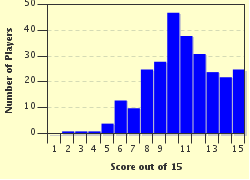Quiz Answer Key and Fun Facts
1. Welcome to the Intensive Care Unit! First things first, the nurses must take handover. This is when the Nurse in Charge on the previous shift make a report on all the patients to the new shift, and patients are allocated to the nurses. But there are so many new words and terms! You and I are allocated a Level 3 patient - but what does this mean?
2. Once we have received our patient and introduced ourselves, it is very important that the bedspace is checked to ensure all our vital equipment is nearby and in good working order. Which of the following pieces of equipment will probably not be in your bedspace - but must be immediately checked too?
3. There! Satisfied everything in our work space is in order, we must now assess our patient from top to toe. To do this, we use the ABCDE approach. This involves assessing the patient's airway, breathing, circulation, disability, and exposure. Which of the following methods would not generally be used to make an assessment of someones airway and breathing?
4. Whilst assessing our patient's circulation, it is noted that she has a pulse rate of 112 beats per minute, instead of the normally acceptable 60-100 bpm. Which technical term do we use to describe a heart rate that is going too quickly?
5. Assessing a patient's disability and exposure status incorporates quite a few things. Which of the following would we not do when assessing this aspect of our patient?
6. I've decided to take an arterial blood sample to analyse. Helpfully, patients in Intensive Care usually have a line or cannula in their artery for easy access so no needles are involved! The machine tells me that the blood analysed has a pH of 7.30, a pCO2 level of 7.29 kPa, and a pO2 of 9.8 kPa.
But what do all these numbers mean?!
7. On the blood gas results, it was also found that our patient has a low potassium level. Outside of Intensive Care, potassium can be given in soluble tablet form. However, as our patient is on a ventilator and therefore cannot swallow, and we are continuously monitoring their vital signs, we are able to administer potassium via an infusion. Although potassium is vital for many biological processes, you must be very careful when administering it as it can be dangerous.
What must you ensure before you administer potassium? (Assuming that it is correctly prescribed and you are giving it to the right patient at the right time.)
8. Thankfully, we now have a quieter few minutes to be able to carry out some essential core nursing care. It's not all about machinery and medicines you know! You gather together a bowl of warm water, some gentle soap, some disposable wipes, and some clean sheets as we prepare to give our patient a wash and change the sheets.
After washing her face and front, we roll our patient on to her side so her back may be washed and the sheet changed. As we do this, we notice that she has arrived on our Unit with a Grade 1 sacral pressure sore. How would you describe a Grade 1 pressure sore?
9. Finally, it's lunchtime! And that means for our patient too. Because our patient is ventilated via a tube in their throat and is unconscious, we have to think of other ways of feeding her - her body requires many vital nutrients in order to heal. From the list below, which is NOT a way of feeding a patient?
10. Our poor patient isn't having a good day! I notice that her blood pressure is lower than it was earlier, and her heart rate is higher. In fact, her pulse rate is higher than her blood pressure! What is the name of this clinical sign?
11. Upon further examination, I find my patient is also pyrexial. This means...
12. I have decided to inform the doctor, as her drop in blood pressure, raised heart rate, and pyrexia suggest our patient may be septic (have a severe infection). Which of these drugs is the doctor most likely to immediately prescribe for sepsis?
13. You should continue to talk to your patient, introducing yourself and explaining any procedures, even if they are sedated and unconscious.
14. It's nearly the end of a very long shift, hurrah! But before we get to go home, we need to make sure that all our documentation and nursing records are up to date. These are written or computerised records of care given, medications administered, and observations made. But why do you need to make sure you write everything down in a clear, concise way?
15. Well done for surviving your first shift in the Intensive Care Unit! And what an eventful day it has been! In fact, you have been so busy that you have not yet given a drug that was due half an hour ago. It is an injection called dalteparin, and helps to prevent blood clots forming as the patient is not mobile. You quickly and carefully give the injection before handing over to the next nurse and heading for home.
But first: what other measures can be taken to help prevent blood clots?
Source: Author
crazy baby
This quiz was reviewed by FunTrivia editor
WesleyCrusher before going online.
Any errors found in FunTrivia content are routinely corrected through our feedback system.

